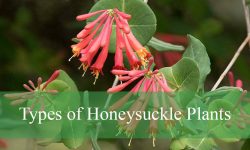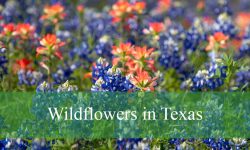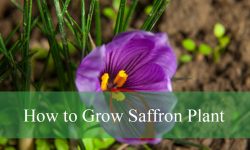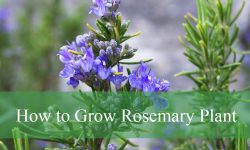Texas boasts a diverse and vibrant array of wildflowers, and among them, purple wildflowers hold a special allure. In this comprehensive guide, we’ll explore 52 stunning types of purple wildflowers that thrive in the vast landscapes of Texas.
1. Eurybia paludosa (southern swamp aster)
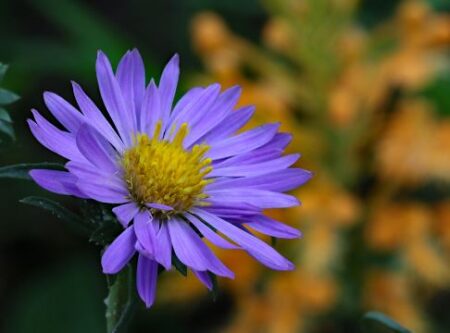
The Southern Swamp Aster, or Eurybia paludosa, is a native North American wildflower found in wetlands across the United States. It stands 2 to 4 feet tall with lance-shaped, toothed leaves arranged alternately along its stems. It’s known for its small, purple to lavender-blue daisy-like flowers with yellow centers and usually appears late summer to fall. This aster’s distinguishing feature is its preference for wetland habitats, such as swamps and bogs, where it thrives due to consistently moist conditions.
2. Glandularia pulchella (South American mock vervain)
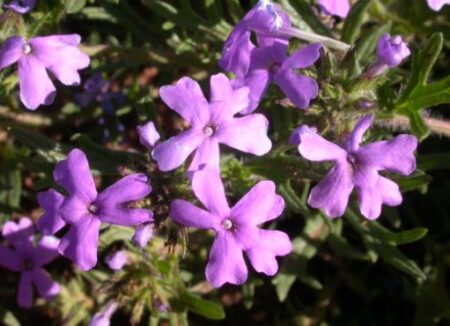
Glandularia pulchella, also known as South American Mock Vervain, is a distinctive wildflower native to South America. It grows in low, spreading clumps, reaches heights of 12 to 24 inches, and features deeply lobed leaves. Its spikes of small, tubular flowers, ranging in shades from purple to white, attract pollinators like butterflies and bees. This adaptable wildflower is commonly found in open fields, meadows, and along roadsides, adding vibrant color to its surroundings.
3. Centrosema virginianum (Spurred Butterfly Pea)
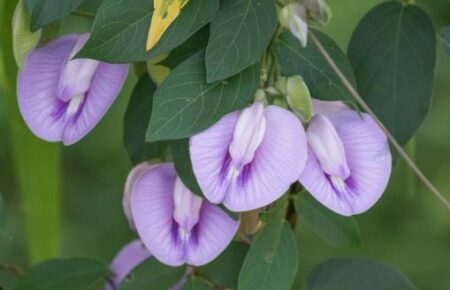
Spurred Butterfly Pea, also known as Wild Blue Vine, Blue Bell, and Wild Pea, is a versatile perennial that thrives in USDA Hardiness Zones 7a-7b. It reaches a mature height of 2-5 feet, blooms in late spring and early summer, and can thrive in full sun to partial shade.
4. Verbena Brasiliensis (Brazilian Vervain)
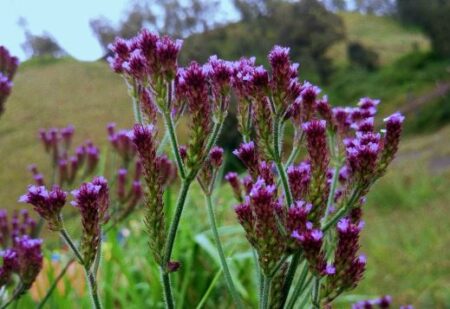
Brazilian Vervain, or Verbena brasiliensis, is an annual plant known for its vibrant presence. It thrives in USDA Hardiness Zones 7-10, reaching a height of 18-36 inches. Its striking purple flowers bloom from mid-spring to mid-fall, attracting pollinators like bees, butterflies, and birds. This sun-loving plant is a valuable addition to gardens.
5. Lobelia puberula (Downy Lobelia)
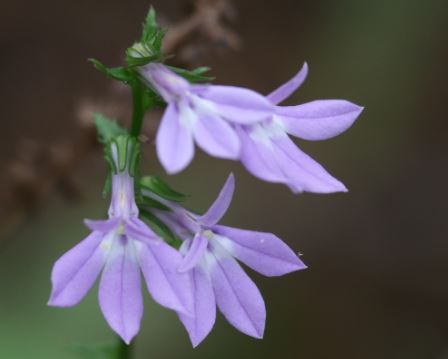
Downy Lobelia, also known as Blue Lobelia and Hairy Lobelia, is a captivating perennial plant. It thrives in USDA Hardiness Zones 4a-9b, grows 24-48 inches tall, and blooms with stunning bluish-purple flowers in late summer, early fall, and mid-fall. This adaptable wildflower can thrive in various light conditions, making it a versatile addition to gardens, especially in moderate to moist Texas habitats.
6. Cirsium horridulum (Purple Thistle)
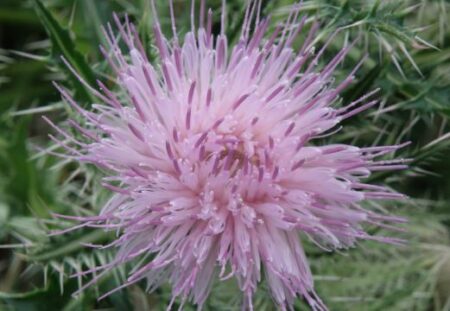
Purple Thistle, also known as Bristle Thistle, Spiny Thistle, and Horrid Thistle, is a hardy plant found in USDA Hardiness Zones 8-11. It comes in both annual and perennial varieties and typically grows 1-4 feet tall. This thistle blooms in spring and prefers full to partial sun. Caution is advised when handling it due to its sharp spines.
7. Wisteria sinensis (America Wisteria)
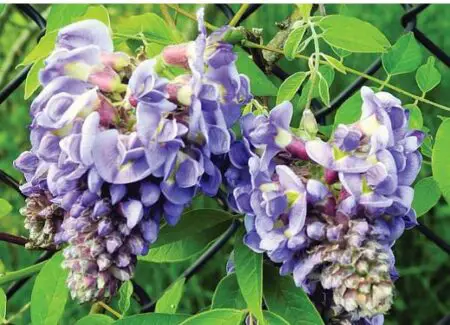
American Wisteria, or Wisteria sinensis, is a captivating perennial vine known for its impressive growth potential, reaching 10-40 feet. It blooms beautifully in late spring and early summer, thriving in both full and partial sun. However, it’s toxic if ingested, so caution is advised.
8. Ruellia caroliniensis (Carolina Wild Petunia)
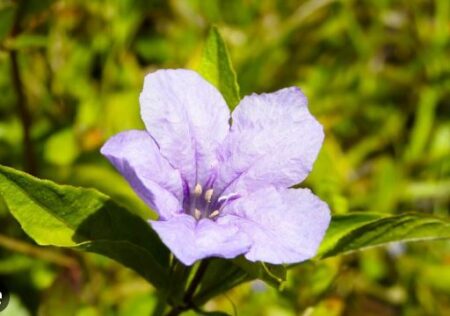
Carolina Wild Petunia, or Ruellia caroliniensis, is a versatile perennial thriving in USDA Hardiness Zones 8-11. It’s compact, reaching 6-12 inches in height, and blooms charmingly during the summer. This adaptable plant grows well in partial sun and shade, making it a valuable addition to gardens. Notably, it hosts caterpillars like those of the Buckeye Butterfly, enhancing its role in pollinator-friendly landscapes.
9. Passiflora incarnate (Purple Passionflower)
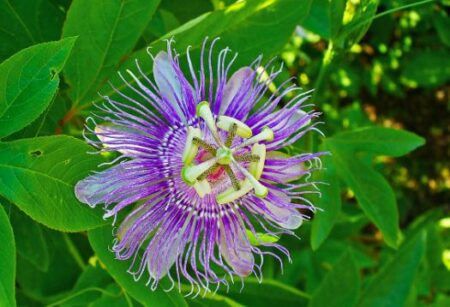
Purple Passionflower, or Passiflora incarnata, is a versatile perennial known by various names like Maypop and True Passion Flower. Thriving in USDA Hardiness Zones 6b-10b, it reaches a mature height of 6-8 feet and blooms fragrantly from mid-summer to mid-fall. This plant is adaptable to both full sun and partial sun conditions and produces a unique fruit called a “maypop,” starting green and turning yellow as it matures, adding to its allure.
10. Scutellaria elliptica (Hairy Skullcap)
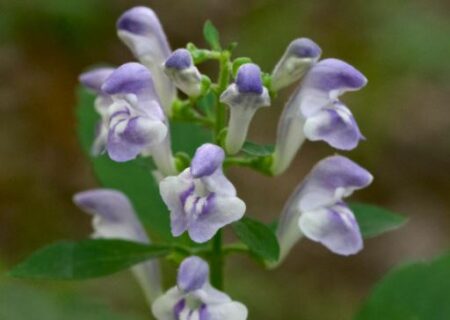
Hairy Skullcap, or Scutellaria elliptica, is a resilient perennial plant with various names, including Common Large Skullcap, Helmet Flower, Rough Skullcap, and Tall Skullcap. It thrives in USDA Hardiness Zones 6b-8a, growing 6-36 inches tall and blooming in late spring and mid-fall. This versatile plant can thrive in different light conditions and is often found in Texas meadows and prairies.
11. Vernonia gigantean (Giant Ironweed)
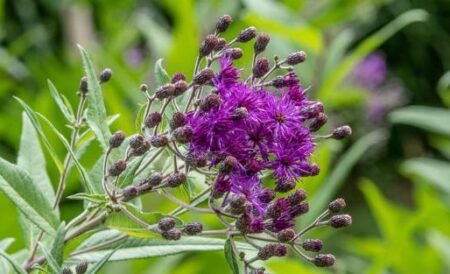
Giant Ironweed, or Vernonia gigantea, is a robust perennial plant that thrives in USDA Hardiness Zones 5a-9a. It grows 4-8 feet tall and blooms with striking dark purple flowers in summer and fall. This adaptable plant can thrive in full sun to partial shade and is a favorite among butterflies like swallowtails and Monarchs.
12. Salvia lyrata (Lyreleaf Sage)
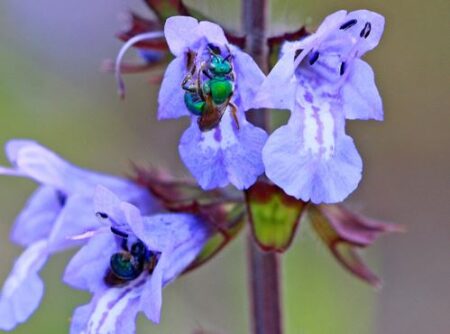
Lyreleaf Sage, or Salvia lyrata, is a versatile perennial plant known by various names like Wild Sage and Cancer Weed. It adapts well to USDA Hardiness Zones 5a-10b, growing to a compact size of 12-24 inches. Blooming in spring and summer, it thrives in both full sun and partial shade. Interestingly, its flower color intensifies in more shade, and its young leaves have a minty taste, making them suitable for salads.
13. Houstonia purpurea (Venus’ Pride)
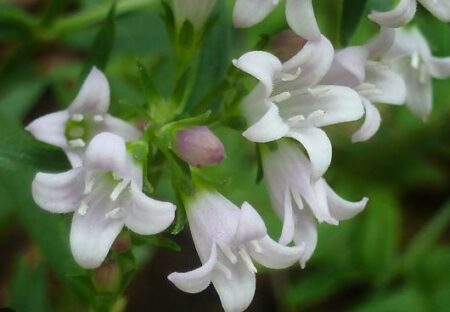
Venus’ Pride, or Houstonia purpurea, is a versatile perennial plant known by various names like Purple Bluet and Summer Bluet. It thrives in USDA Hardiness Zones 3-8, growing 6-12 inches tall and blooming beautifully in spring. This adaptable plant can thrive in various light conditions and is often found in dry fields, forests, or meadows in Texas, enhancing the natural beauty of these landscapes.
14. Nuttallanthus texanus (Texas Toadflax)
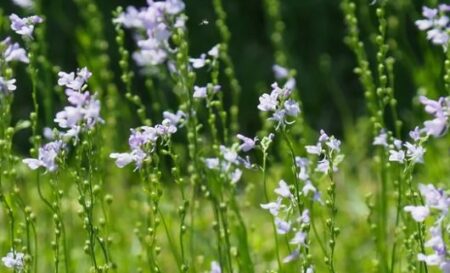
Texas Toadflax, or Nuttallanthus texanus, is a vibrant wildflower found in USDA Hardiness Zones 4a-8a. It varies in size from 4 to 24 inches and boasts striking purple blooms from mid-spring through summer. Thriving in full sun, it adapts to diverse habitats across Texas, including grasslands, sandy areas, forests, and rocky slopes, enhancing their natural beauty.
15. Liatris Aspera (Rough Blazing Star)
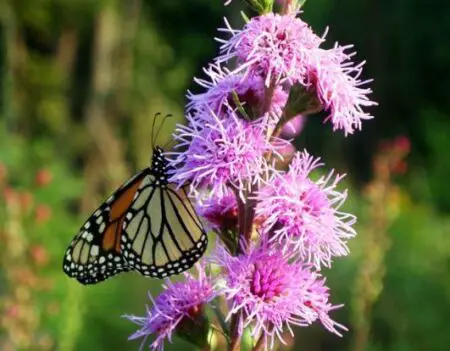
Rough Blazing Star, or Liatris aspera, is a versatile perennial plant with multiple names. It thrives in USDA Hardiness Zones 3a-10b, growing 16-48 inches tall and blooming beautifully in summer and fall. This low-maintenance plant adapts to various light conditions and stands out with its unique clumped flower arrangement along the stalks, setting it apart from other purple wildflowers in Texas.
16. Campanula Americana (Tall Bellflower)
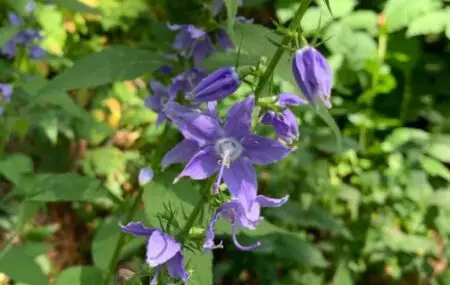
The Tall Bellflower, or Campanula americana, is a versatile perennial wildflower found in USDA Hardiness Zones 4-7. It grows 3-6 feet tall and boasts beautiful summer blooms. Thriving in various light conditions, it can be seen in partial shade along woodland edges, open woods, shaded meadows, streambanks, and ditches in Texas. Interestingly, it depends on pollinators like long-tongued bees, Halictid bees, butterflies, and skippers for reproduction.
17. Viola bicolor (Field Pansy)
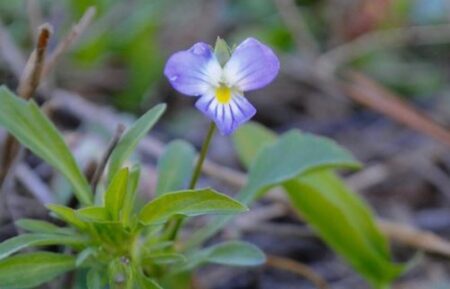
The Field Pansy, or Viola bicolor, is a charming annual wildflower found in USDA Hardiness Zones 4-10. It grows 2-16 inches tall and blooms with attractive flowers in spring and summer. This adaptable wildflower thrives in various light conditions and can be commonly seen in Texas, where it attracts wildlife like bees and serves as food for caterpillars and birds.
18. Symphyotrichum dumosum (Rice Button Aster)
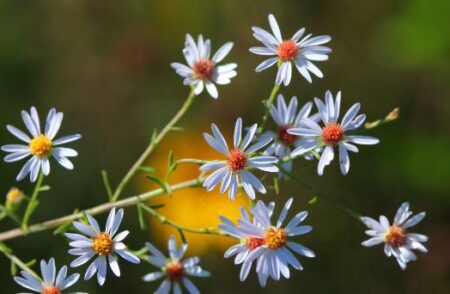
The Rice Button Aster, or Symphyotrichum dumosum, is a versatile perennial wildflower found in USDA Hardiness Zones 4a-8b. It grows 12-36 inches tall and features delicate, very light purple blooms in late summer and early fall. This sun-loving plant is popular among pollinators, especially butterflies and native bees, and serves as a larval host for the Pearl Crescent Butterfly. In warmer climates, it can bloom year-round, adding color to landscapes throughout the seasons.
19. Geranium maculatum (Wild Geranium)
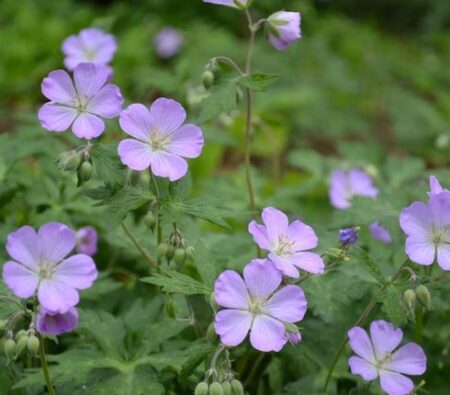
Geranium maculatum, also known as Wild Geranium or Cranesbill, is a versatile perennial wildflower that can be found in USDA Hardiness Zones 3a-8b. Typically growing to a height of 12-24 inches (30-60 cm), it adds charm to gardens and natural landscapes with its delicate purple blooms during late spring, early summer, and mid-summer. This adaptable wildflower thrives in various light conditions, from full sun to partial shade, commonly seen in dry to moist Texas forests, enhancing the natural beauty of these environments.
20. Primula meadia (Eastern Shooting Star)
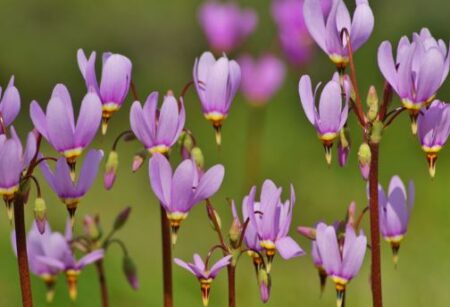
Primula meadia, commonly known as Eastern Shooting Star, is a captivating perennial wildflower with several alternative names, including American Cowslip, Indian Chief, and Rooster Heads. Thriving in USDA Hardiness Zones 4a-7b, it typically grows to a height of 10-20 inches (25-50 cm) and adorns natural landscapes with its striking late spring and early summer blooms. This versatile wildflower thrives in both sun and partial shade and is often found in forests and prairies. It features a unique growth pattern where the purple flowers initially droop downward but then the flower stalk becomes upright after pollination, and the seeds are dispersed by gusts of wind.
21. Campanula rotundifolia (Harebell)
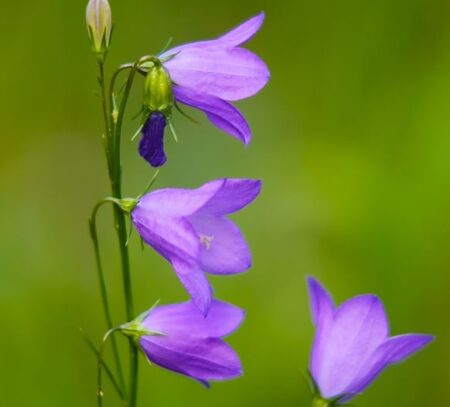
Campanula rotundifolia, commonly known as Harebell, is a versatile perennial wildflower with several alternate names, including Bluebell, Scottish Bluebells, Bluebells of Scotland, Roundleaf Bellflower, and Scottish Harebel.
Adapting well to a range of climates, Harebell can be found in USDA Hardiness Zones 3a-8b. It typically reaches a mature size of 6-20 inches (15-50 cm), adding a delicate touch to gardens and natural landscapes during the summer and fall.
Harebell is versatile when it comes to sunlight, thriving in both full sun and sun to partial shade conditions. Notably, it features a very thin stem that exudes a milky sap. This charming purple wildflower is a versatile species, found in various habitats throughout Texas, contributing to the natural beauty of its surroundings.
22. Agalinis purpurea (Purple False Foxglove)
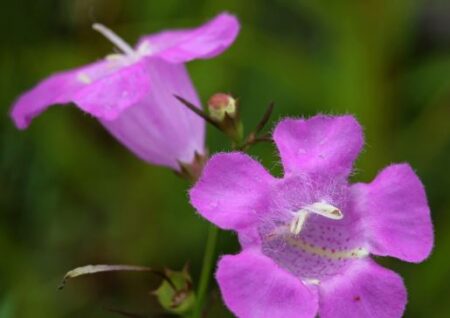
Agalinis purpurea, also known as Purple False Foxglove or Purple Gerardia, is a versatile annual wildflower.
Adapting to a range of climates, it can be grown in Texas gardens with a USDA Hardiness Zone range of 2a-10b. It typically reaches a mature size of 12-36 inches (30-91 cm) and graces the landscape with its pretty purple blooms during the summer and fall.
This adaptable wildflower thrives in full sun and prefers moist sandy soils for optimal growth. Notably, it is semiparasitic, obtaining some of its nutrients from neighboring plants, including native grasses, Loblolly Pines, Sycamore, or Sweetgum Trees. This unique feature enables it to thrive in diverse natural environments.
23. Verbena stricta (Hoary Vervain)
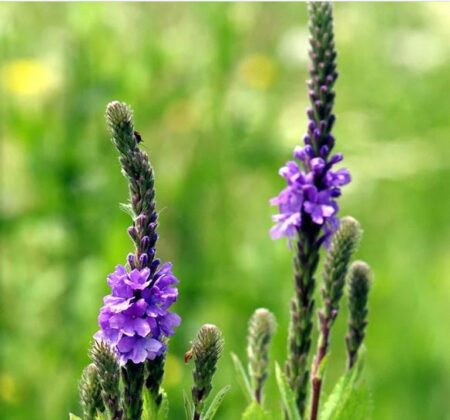
Verbena stricta, commonly known as Hoary Vervain or Tall Vervain, is a versatile perennial wildflower found in USDA Hardiness Zones 3a-9a. Typically reaching a mature size of 1-3 feet (30-90 cm), it adds medium purple beauty to meadows, fields, and dry, sandy soils during the summer. Remarkably drought-resistant, Hoary Vervain is a valuable addition to water-conscious landscapes.
Notably, this wildflower is important for supporting local wildlife as the leaves are the preferred food source for Common Buckeye Butterfly caterpillars. It is an essential component of pollinator-friendly gardens.
24. Cirsium discolor (Field Thistle)
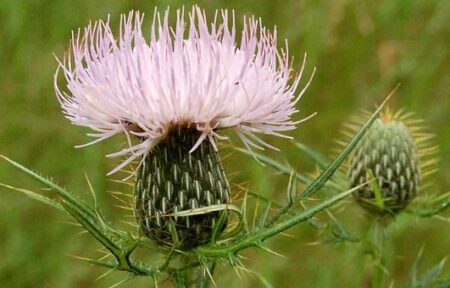
Cirsium discolor, also known as Field Thistle or Pasture Thistle, is a perennial wildflower thriving in USDA Hardiness Zones 3-9. It typically grows 3-5 feet (90-150 cm) tall and is commonly found in damp, sunny areas along roadsides and in open fields in Texas during the summer. Field Thistle’s large flower heads, rich in nectar and pollen, attract a variety of pollinators, including butterflies like monarchs, bees, wasps, bumblebees, and hummingbirds, making it a valuable addition to landscapes and gardens.
25. Oxalis violacea (Violet Wood Sorrel)
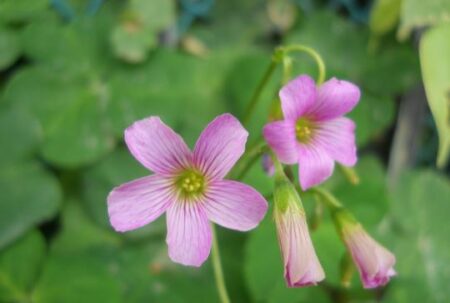
Oxalis violacea, or Violet Wood Sorrel, is a native perennial plant known by various names, including Sour Grass, Sour Trefoil, and Shamrock.
This delicate plant thrives in USDA Hardiness Zones 5a-11 and typically grows to a mature height of 4-8 inches (10-20 cm). It can be found in open spaces within damp woods, along stream banks, and in moist prairies, displaying its charming springtime blooms.
Notably, all parts of the Violet Wood Sorrel are edible but should be consumed in moderation due to their high oxalic acid content, which can be toxic in large quantities.
26. Amphicarpaea bracteata (American Hog Peanut)
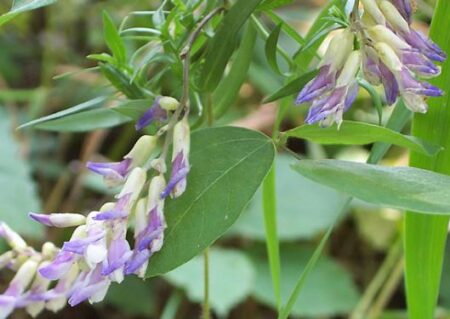
Amphicarpaea bracteata, commonly known as American Hog Peanut or Ground Bean, is a unique plant among purple wildflowers in Texas.
This plant can adapt to various conditions and typically grows in USDA Hardiness Zone 5b. It reaches a mature size of 1-5 feet (30-152 cm) and blooms during the summer and fall.
What makes the American Hog Peanut stand out is its dual flowering strategy. Upper flowers are open and rely on insects for pollination, while lower flowers grow on low or underground vines and never fully open, allowing them to self-pollinate. This unique feature demonstrates the plant’s adaptability and reproductive versatility.
27. Galearis spectabilis (Showy Orchis)
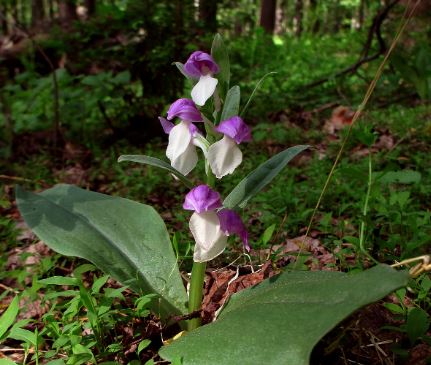
Galearis spectabilis, also known as Showy Orchis or Showy Orchid, is a captivating perennial wildflower that typically grows 5-12 inches (12.5-30 cm) tall. Thriving in USDA Hardiness Zones 4-7, it graces the landscape with striking springtime blooms. Commonly found in shady hillside habitats beneath deciduous trees, this orchid rarely sees full sun. Apart from its beauty, it plays a vital ecological role by providing nectar for important pollinators like bumblebees, butterflies, and moths, contributing to ecosystem health and diversity.
28. Lobelia siphilitica (Great Blue Lobelia)
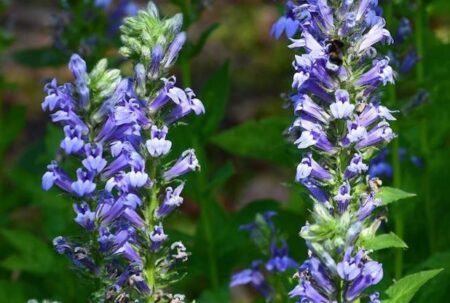
Lobelia siphilitica, also known as Great Blue Lobelia, Great Lobelia, or Blue Cardinal Flower, is a captivating perennial wildflower. Thriving in USDA Hardiness Zones 4a-9b, it typically reaches a mature height of 1-4 feet (30-120 cm) and graces the landscape with stunning summer and fall blooms.
Great Blue Lobelia relies on pollinators like insects, bumblebees, and hummingbirds for reproduction, as it does not self-pollinate. This purple wildflower prefers moist to wet soils and is commonly found in partially shaded environments such as swamp forests, roadside ditches, floodplains, lake margins, and wet prairies, contributing to the beauty and biodiversity of these ecosystems.
29. Solanum dulcamara (Bittersweet Nightshade)
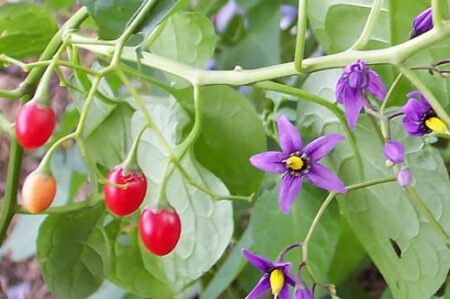
Solanum dulcamara, also known as Bittersweet Nightshade or by various other names, is a perennial plant adapted to USDA Hardiness Zones 4a-8b. It typically grows to a height of 2-8 feet (60-240 cm) and blooms during spring, summer, and fall in sun to light shade conditions. Importantly, all parts of this plant are toxic to humans if ingested, and its foliage is also harmful to animals. Caution is advised when dealing with this plant to prevent harm to both people and animals.
30. Nuttallanthus Canadensis (Canada Toadflax)
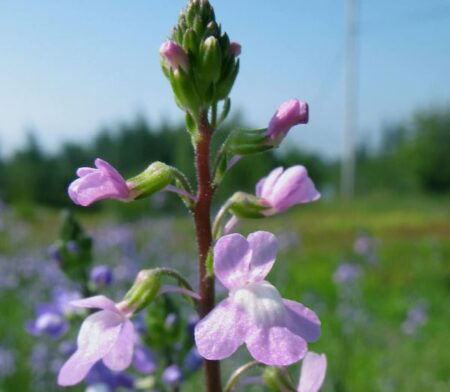
Nuttallanthus Canadensis, commonly known as Canada Toadflax or Blue Toadflax, is a petite wildflower that thrives in USDA Hardiness Zones 4a-8a. It typically reaches a mature height of 8-10 inches (20-45 cm) and features vibrant blue flowers that bloom in early spring, providing critical nectar for honeybees and butterflies. Additionally, its leaves are a valuable food source for caterpillars, making it an essential part of local ecosystems and a charming addition to landscapes.
31. Ipomoea purpurea (Tall Morning Glory)
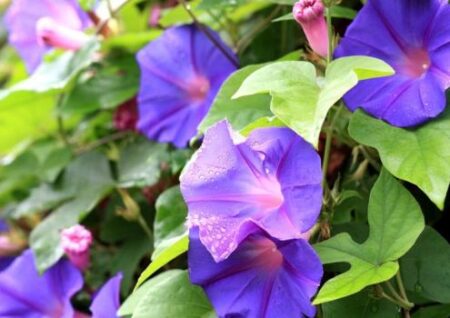
Ipomoea purpurea, commonly known as Tall Morning Glory or Purple Morning Glory, is a wildflower with unique characteristics.
This annual plant thrives across a wide range of USDA Hardiness Zones, from 2 to 11, and can grow to an impressive height of 12-15 feet (3.7-4.6 meters). It displays its charming blooms during the summer and fall. It exhibits adaptability by growing in both dry and rich soils
32. Hesperis matronalis (Dame’s Rocket)
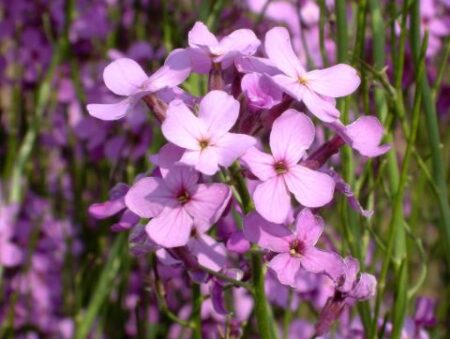
Hesperis matronalis, or Dame’s Rocket, is a versatile wildflower found in various regions, including Texas. Adapting to USDA Hardiness Zones 3-9, this plant can be biennial or short-lived perennial and typically reaches a height of 1-4 feet (30-122 cm). It graces the landscape with its early to mid-spring blooms and is known for its fast-spreading nature, often found in meadows and woodlands throughout Texas. Additionally, the young leaves of this flower are high in Vitamin C and can be added to salads for a slightly bitter taste, adding diversity to culinary experiences.
33. Purple Loosestrife (Lythrum salicaria)
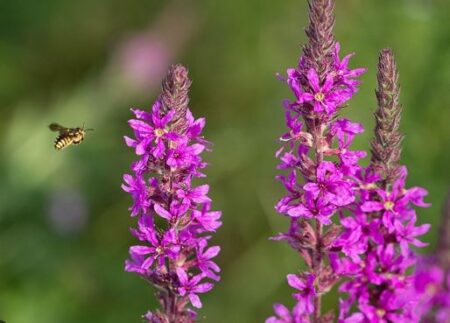
Purple Loosestrife (Lythrum salicaria) is a perennial wildflower commonly found in various Texas habitats. Adapting to USDA Hardiness Zones 3a-9b, it typically reaches 2-5 feet (60-150 cm) in height and blooms during the summer. This vibrant wildflower is often seen in ditches, wet meadows, marshes, and along lakeshores, where it thrives in full sun.
34. Glechoma hederacea (Creeping Charlie)
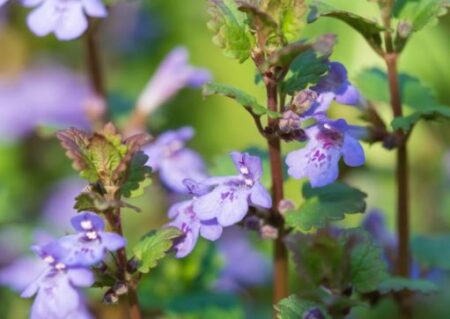
Glechoma hederacea, or Creeping Charlie, is a versatile perennial wildflower found in USDA Hardiness Zones 3a-10b. It typically grows to a mature height of 5-8 inches (12.5-20 cm) and displays delicate spring and summer blooms.
Creeping Charlie thrives in moist, semi-shaded areas and can often be found in large groups. It plays a valuable role in supporting local wildlife, as many species of wild bees collect pollen from this plant, contributing to the ecosystem’s health and diversity.
35. Centaurea stoebe (Spotted Knapweed)
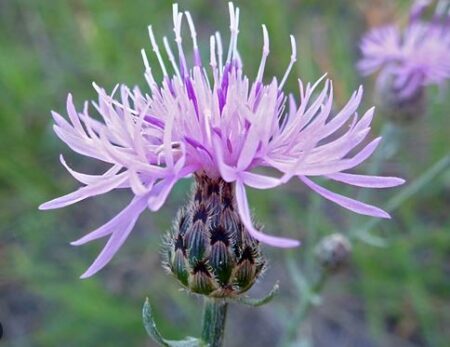
Centaurea stoebe, commonly known as Spotted Knapweed or Panicled Knapweed, is a biennial wildflower that flourishes in various regions, including Texas.
Adapting to USDA Hardiness Zones 3a-10b, this plant typically grows to a mature height of 2-3 feet (60-90 cm). Its vibrant blooms grace the landscape during the summer and fall.
Spotted Knapweed is a familiar sight along roadsides and in open fields throughout Texas, adding a splash of color to these natural environments. With its affinity for full sun, it thrives in bright and sunny conditions, contributing to the beauty of the Texas landscape.
36. Monarda fistulosa (Bee Balm)
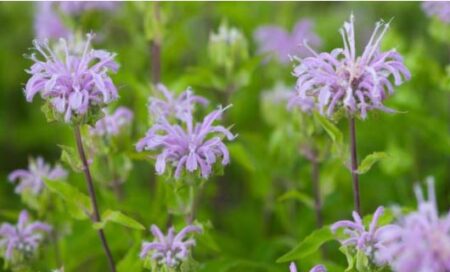
Bee Balm, or Monarda fistulosa, is a versatile perennial wildflower found in USDA Hardiness Zones 3a-9b. It typically grows to a mature height of 2-4 feet (60-120 cm) and blooms with vibrant flowers in the summer. Bee Balm leaves can be used to make a refreshing tea with antimicrobial properties, potentially helping with colds and the flu. You can spot this fragrant plant with lilac-purple flowers in dry areas of fields, prairies, and along roadsides in Texas, adding natural beauty to these landscapes.
37. Pueraria montana (Kudzu)
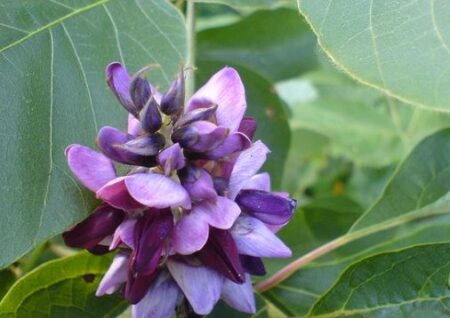
Pueraria montana, commonly known as Kudzu or by alternative names like Japanese Arrowroot, Kudzu Bean, and Kudzu Vine, is a perennial wildflower.
Adapting to USDA Hardiness Zones 5b-11, it can grow to an impressive mature size of 30-100 feet (9.1-30 meters) and blooms with purple flowers during the summer and fall.
However, it’s crucial to be aware that Kudzu is highly invasive in Texas, spreading rapidly through various means, including human activities, as well as with the help of mammals and birds.
38. Triodanis perfoliata (Clasping Venus’ Looking Glass)
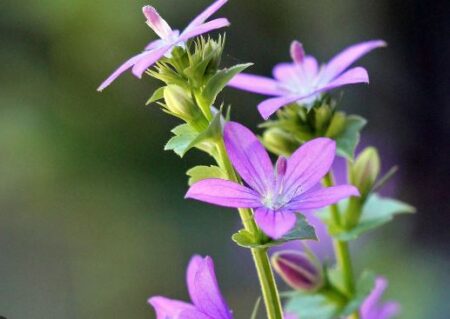
Triodanis perfoliata, commonly known as Clasping Venus’ Looking Glass or Roundleaf Triodanis, is an annual wildflower that adapts to a wide range of USDA Hardiness Zones (2-11). Typically reaching a mature height of 6-36 inches (15-91 cm), it blooms during the spring and summer months.
In Texas, this purple wildflower thrives in habitats with dry sandy soils, including disturbed areas, gardens, and woodlands. One notable feature is its ability to self-pollinate, and it also attracts various small butterflies, bees, and flies
39. Arctium minus (Common Burdock)
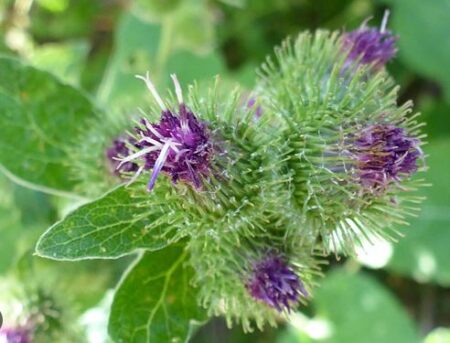
Arctium minus, or Common Burdock, is a biennial wildflower that thrives in USDA Hardiness Zones 4a-10b, typically reaching a mature height of 4-6 feet (120-180 cm). Its striking deep purple flowers, reminiscent of rhubarb, make it easily recognizable.
This versatile plant can be found in various Texas environments, including pastures, open prairies, hayfields, roadsides, old fields, barnyards, railways, and other disturbed areas. Its ability to adapt to different habitats contributes to its widespread presence in the state, enhancing the natural beauty of these landscapes.
40. Vicia villosa (Winter Vetch)
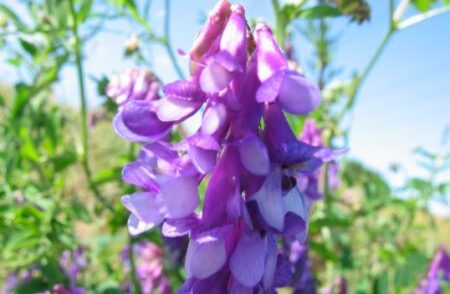
Vicia villosa, or Winter Vetch, is a versatile plant that adapts to USDA Hardiness Zones 4-7, with an annual, biennial, or perennial life cycle and a typical height of 1-3 feet (30-91 cm). It blooms during the summer and fall and is often used as a companion plant for tomatoes due to its nitrogen-enriching properties, which help prevent weed growth. In the wild, Winter Vetch thrives in various environments, from forests and meadows to roadsides and disturbed areas, making it a valuable component of natural landscapes.
41. Symphyotrichum leave (Smooth Blue Aster)
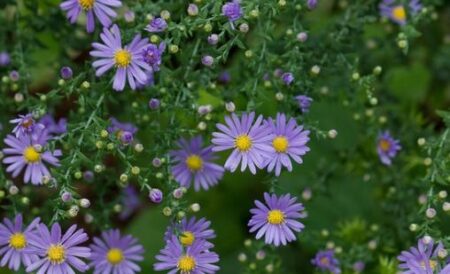
Symphyotrichum laeve, or Smooth Blue Aster, is a resilient perennial wildflower that thrives in USDA Hardiness Zones 3-9. Typically growing to a height of 1-3 feet (30-90 cm), it graces plains, meadows, and hillsides in Texas with charming summer and fall blooms. Its unique pappi, resembling dandelion hairs, helps its seeds disperse in the wind, ensuring its presence in various ecosystems.
42. Medicago sativa (Alfalfa)
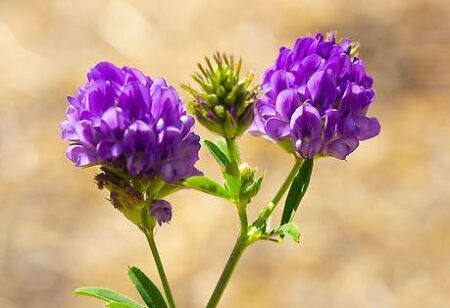
Medicago sativa, commonly known as Alfalfa or Lucerne, is a perennial wildflower that thrives in USDA Hardiness Zones 3a-11. Typically reaching a mature height of 1-3 feet (30-90 cm), this plant graces the landscape with its blooms during the spring, summer, and fall.
Alfalfa, while not a native wildflower, has adapted well to warmer climates and has become a valuable resource for pollinators. Its flowers attract a variety of bees, butterflies, and birds, contributing to the biodiversity of the ecosystems it inhabits. With its affinity for full sun, Alfalfa thrives in sunny conditions, making it a robust and attractive addition to natural landscapes.
43. Cirsium vulgare (Bull Thistle)
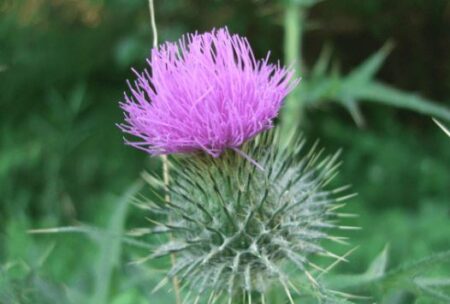
Cirsium vulgare, or Bull Thistle, is a robust biennial wildflower found in various regions. Adapting to USDA Hardiness Zones 3a-8b, this plant typically grows to a mature height of 2-6 feet (0.6-1.8 meters) and displays its striking blooms during the summer and fall.
Bull Thistle is notable for its spiny appearance and serves as a magnet for giant bees and butterflies, making it a valuable addition to gardens and natural landscapes where pollinators are welcome.
44. Texas Bluebonnet (Lupinus texensis)
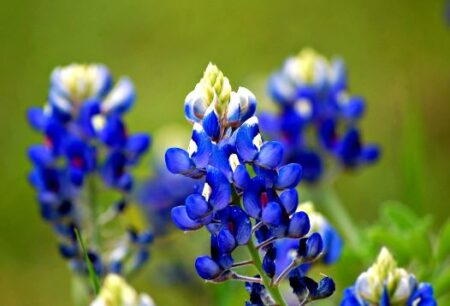
The Texas Bluebonnet, the state flower of Texas, is an iconic purple wildflower. With its signature spike of blue-purple petals, it paints the Texan landscape with color during the spring months. Bluebonnets can be found in open fields and along roadsides, symbolizing the spirit of Texas.
45. Mexican Hat (Ratibida columnifera)
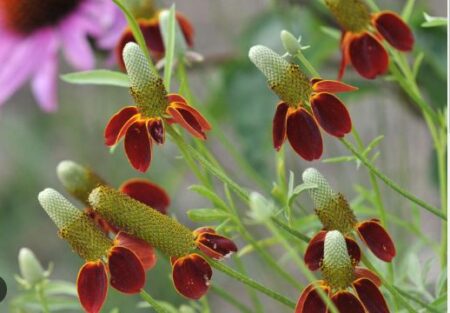
Also known as the Prairie Coneflower, the Mexican Hat features a unique purple-brown, sombrero-like flowerhead. This wildflower thrives in Texas, particularly in meadows and prairies, and adds a touch of whimsy to the scenery.
46. Spiderwort (Tradescantia)
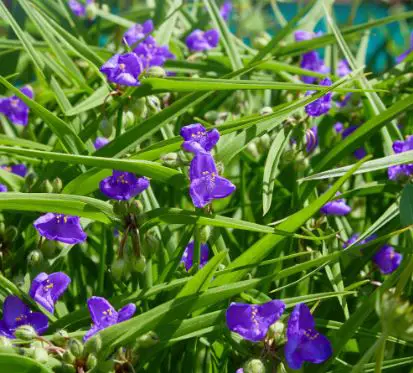
Spiderworts are known for their vibrant, deep purple-blue petals and grass-like foliage. These hardy wildflowers grow in a variety of habitats across Texas, from forests to gardens. Their striking blooms appear during the spring and summer months.
47. Texas Paintbrush (Castilleja indivisa)
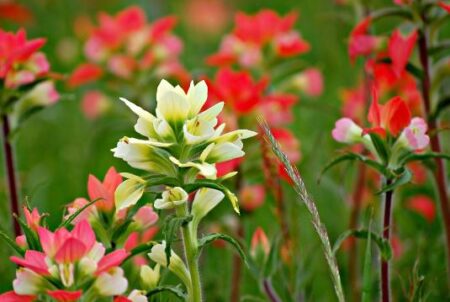
The Texas Paintbrush, with its vibrant red or orange bracts, often has a purple-tinged appearance. It’s commonly found in Texas and complements other wildflowers in fields, creating a picturesque landscape.
48. Winecup (Callirhoe)
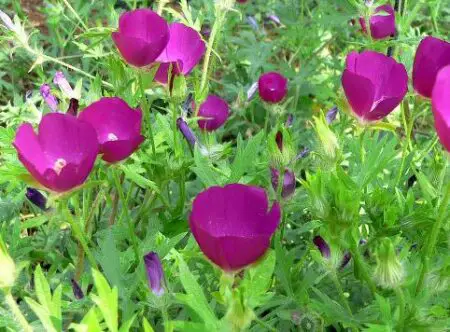
Winecups, with their distinctive, cup-shaped purple flowers, grace Texas roadsides, gardens, and rocky slopes. These perennial wildflowers are known for their ability to withstand the Texan heat.
49. Prairie Verbena (Glandularia bipinnatifida)
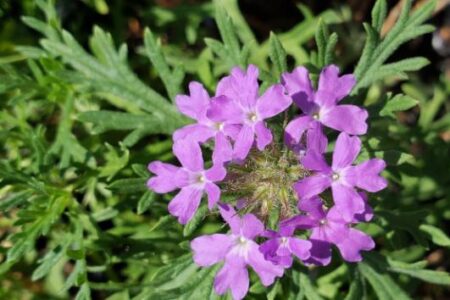
Prairie Verbena displays clusters of small, purple flowers that carpet meadows and open areas across Texas. Their blooms are particularly attractive to pollinators like butterflies and bees.
50. Drummond’s Skullcap (Scutellaria drummondii)
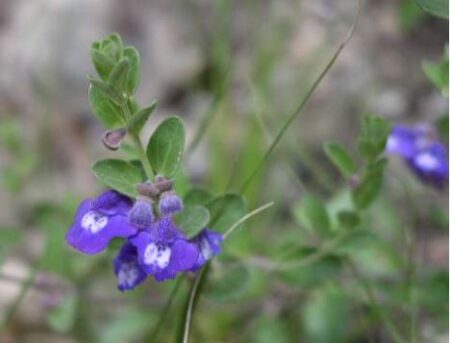
Drummond’s Skullcap (Scutellaria drummondii) is a charming low-growing wildflower known for its petite, tubular, purple-blue flowers. It thrives in sandy soils, making it a resilient and delightful addition to Texas’ natural landscapes.
51. Texas Lantana (Lantana urticoides)
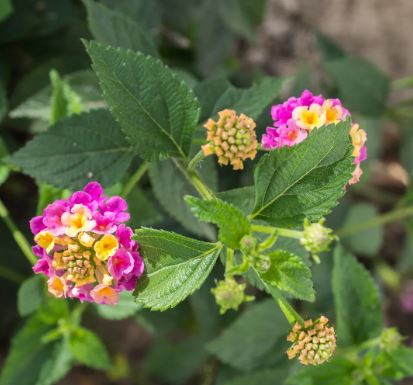
Texas Lantana (Lantana urticoides) is a vibrant wildflower known for its clusters of tubular, purple flowers. These blooms are not only visually stunning but also attract butterflies and other pollinators, making it a valuable asset to local ecosystems and gardens.
52. Blue Curls (Phacelia congesta)
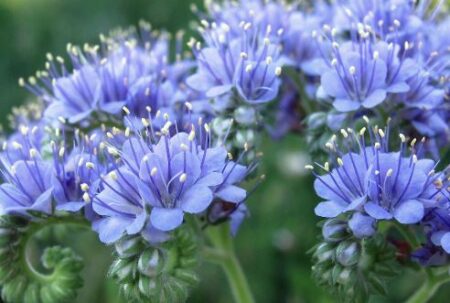
Blue Curls (Phacelia congesta) are distinctive wildflowers that feature coiled inflorescences adorned with beautiful lavender-blue blooms. Their unique appearance adds a touch of elegance to natural landscapes, making them a captivating sight for those who come across them.
The beauty of purple wildflowers in Texas
Texas boasts a breathtaking array of wildflowers, and among the most enchanting are the purple varieties. These stunning purple wildflowers adorn the Texan landscape, painting fields, meadows, and roadsides with their vibrant hues. Their beauty not only captivates the eye but also plays a vital role in supporting the local ecosystem.
Whether you’re traversing the Texan countryside, wandering through meadows, or nurturing your own garden, take a moment to appreciate the sheer beauty and ecological significance of purple wildflowers. They are a testament to nature’s artistry and Texas’ vibrant natural heritage.
Conclusion
Texas is a treasure trove of natural beauty, and its purple wildflowers contribute significantly to its charm. From the iconic Texas Bluebonnet to the whimsical Mexican Hat and the elegant Liatris, these wildflowers add splashes of purple hues to the Texan landscape throughout the year. Explore Texas’ diverse ecosystems to witness these enchanting blooms in their natural habitat.

